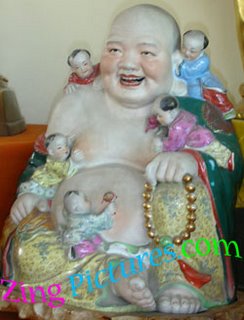Who's the fat guy?
“Who’s the fat guy?” one of the participants in a study group looking at South East Asian art asked me recently. All the statues and images of the Buddha we had discussed in the hour or two before had been slim, svelte, highly stylised in, mostly, traditional Thai representations. Buddha images aren’t ten a penny in Britain, but all I had to do to find the “fat guy”, it turned out, was take a trip to my local garden centre. There he was, rotund, jovial, wide-smile, big belly – the laughing Buddha as water feature, a stream of water pouring from the monk’s bowl held over his head.
Throughout Asia he goes under a whole host of names I won’t confuse you with here, but the one that casts most light on his identity is Pra-Maitreya. While the (slim, stylised) Buddha was a real historical figure - Prince Siddhartha Gautama - the “fat guy” Pra-Maitreya is the Buddha of the Future, the successor to the historical Buddha. So the ‘fat one’ is a real Buddha; but one whose coming we await.
If this figure is the Buddha-to-be then why is he invoked as a guarantor of material possessions, bountiful harvests and female fertility as well as patron of variously, goldsmiths, fortune tellers and bar tenders? The answer is that the Fat Buddha encompasses not one, but three personas. Which means three blogs for the price of one:
He’s the Buddha of the future.
He has an earthly incarnation as a monk, Qi Ci, who is believed to have had real existence in 10th century China.
He’s a bodhisattva, - a saintly being dedicated helping others achieve peace and enlightenment.
The concept of the Maitreya, the Buddha of the future, arose soon after the death of the historical Gautama Buddha and has exercised a strong hold on Buddhists over millennia. It’s possibly comparable to the Second Coming of Christ for Christians.
This “fat guy” personification of the Maitreya came long after that. The bulging sack, the fat belly and the wide smile date from around the 10th century CE and are based on stories of a real Chinese monk of the Buddhist Zen tradition. He carried a cloth bag filled with precious things – rice plants, sweets, even and especially, and benevolently, children. The sack gave him yet another name – Hotei – which translates as ‘cloth bag’
This monk, who called himself Qi Ci was known, appropriately enough, for his contentment and for the simplicity of his life. Legend has it that he had no permanent home but was somehow protected from the elements; he slept in drifts of snow, but was never soaked through or felt the cold. Villagers came to assume that if the monk with the cloth bag slept in the open the weather would be good. If he wore sandals or sought shelter, then villagers expected rain. On a grander scale, he was credited with the ability to foresee the future. Perhaps this is why the Laughing Buddha was adopted as a sort of patron saint of fortune-tellers.
Blog on tomorrow to find out what happens when you rub the Fat Buddha’s tummy and – we aim to please – a Zen parable on the meaning of life.


No comments:
Post a Comment